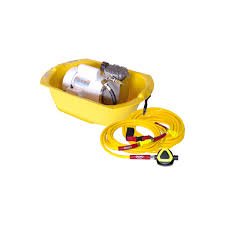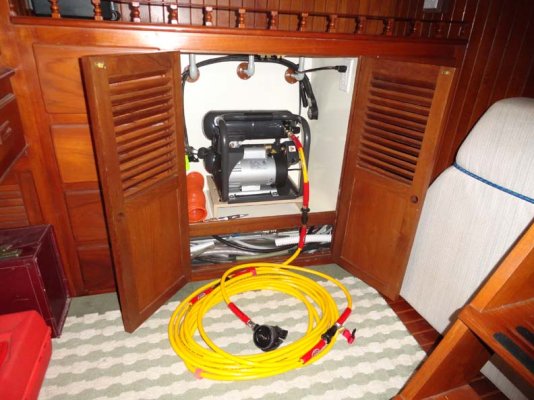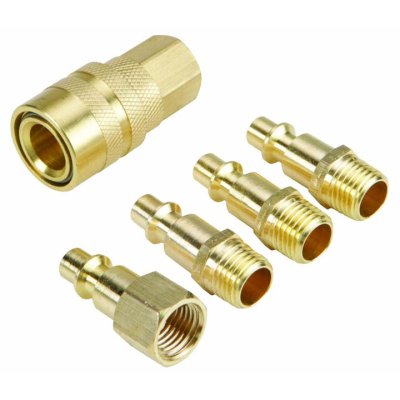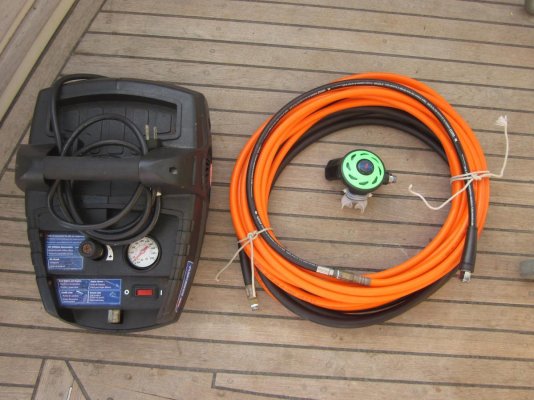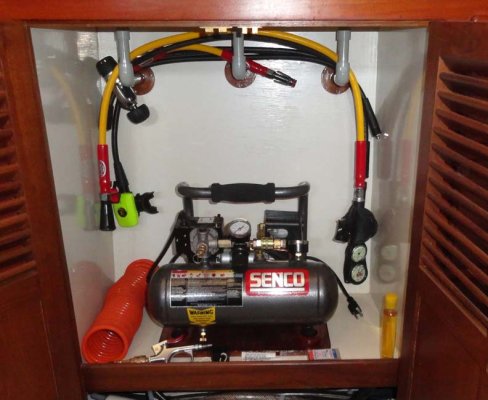You are using an out of date browser. It may not display this or other websites correctly.
You should upgrade or use an alternative browser.
You should upgrade or use an alternative browser.
Dive compressor
- Thread starter N4712
- Start date
The friendliest place on the web for anyone who enjoys boating.
If you have answers, please help by responding to the unanswered posts.
If you have answers, please help by responding to the unanswered posts.
Darylat8750
Veteran Member
- Joined
- Oct 18, 2013
- Messages
- 47
- Location
- USA
- Vessel Name
- Song of San Fransisco
- Vessel Make
- Ocean Alexander
I used one (gas powered) a couple of weeks ago. Works great. The owner stated that if he replaced it he would get an electric one. FWIW
We have one similar that we made. We consider it essential cruising gear. We are both PADI certified and considered tanks but they can be an issue getting filled in some areas plus storage. The hookah gets used for cleaning the bottom/running gear, changing zincs and getting stuff off the bottom that gets dropped at anchor. Ours is good for about 30' and it can run off the invertor or generator.
psneeld
Guru
any oiless compressor will work.
check "homemade hooka" out and you can read for weeks...I did.
even FSTbottoms (pro bottom cleaner) here says there is no real difference as many hooka manufacturers are just using cheapo oiless compressors anyway.
he does recommend using food grade air hose or ones made for the scuba industry....there are 2 sides to that story you can read about too.
I used an old compressor I had around for years...bought a $5 brass adapter so it fit my regulator and all summer I was changing zincs, clearing intakes, etc..etc... best $5 I ever spent...saved me a $400 haul or diver bill to do zincs and bottom cleaning this summer.
check "homemade hooka" out and you can read for weeks...I did.
even FSTbottoms (pro bottom cleaner) here says there is no real difference as many hooka manufacturers are just using cheapo oiless compressors anyway.
he does recommend using food grade air hose or ones made for the scuba industry....there are 2 sides to that story you can read about too.
I used an old compressor I had around for years...bought a $5 brass adapter so it fit my regulator and all summer I was changing zincs, clearing intakes, etc..etc... best $5 I ever spent...saved me a $400 haul or diver bill to do zincs and bottom cleaning this summer.
FF
Guru
- Joined
- Oct 12, 2007
- Messages
- 22,552
Remember the physical relationship between the noisemaker exhaust and the air pump intake is critical!
Shoalwaters
Guru
- Joined
- Feb 24, 2008
- Messages
- 681
- Location
- St. Lucia, West Indies
- Vessel Name
- "Dragon Lady"
- Vessel Make
- DeFever 41
I installed a Senco 1.5hp oil-less compressor (Amazon.com $170.00) in one of the aft cabin lockers. The hose is from Brownie's Third Lung and cost about the same as the compressor. It is stored on hooks above the compressor when not in use. The convenience of not having to get tanks refilled just to dive the bottom of my boat makes the cost well worthwhile.
In additon to hose and compressor, you need a second-stage regulator (the mouthpiece one) and a weight belt.
In additon to hose and compressor, you need a second-stage regulator (the mouthpiece one) and a weight belt.
Attachments
N4712
Guru
- Joined
- Apr 22, 2013
- Messages
- 3,607
- Location
- U.S.A
- Vessel Name
- Oliver
- Vessel Make
- Nordhavn 47 Hull# 12
Thanks, this looks like the best option. Is there any smell in the air well diving? Also how many amps does it draw?I installed a Senco 1.5hp oil-less compressor (Amazon.com $170.00) in one of the aft cabin lockers. The hose is from Brownie's Third Lung and cost about the same as the compressor. It is stored on hooks above the compressor when not in use. The convenience of not having to get tanks refilled just to dive the bottom of my boat makes the cost well worthwhile. In additon to hose and compressor, you need a second-stage regulator (the mouthpiece one) and a weight belt.
O C Diver
Guru
- Joined
- Dec 16, 2010
- Messages
- 12,867
- Location
- USA
- Vessel Name
- Slow Hand
- Vessel Make
- Cherubini Independence 45
+1I just use a long regulator hose. Lay the SCUBA tank on the rear deck, have about 15 feet of hose, and go under to do whatever has to be done.
My hose is 50' so I can do a hull inspection with out moving the tank from midships.
Ted
jleonard
Guru
- Joined
- Jun 25, 2008
- Messages
- 5,063
I also use a 50 ft hose and a regular scuba tank.
However my buddy bought a cheapo oiless pancake style compressor (like the roofing guys use) and that's what he uses....with a standard air hose connected to his regulator. I've never used his rig, but he has many times while we're rafted up.
However my buddy bought a cheapo oiless pancake style compressor (like the roofing guys use) and that's what he uses....with a standard air hose connected to his regulator. I've never used his rig, but he has many times while we're rafted up.
If you make your own, the fitting between the hose and the pig-tail from the second stage regulator can be hard to find. We bought a couple at a commercial dive shop in San Diego. The threads are different. It is my understanding that it is a safety feature to prevent breathing air lines and standard compressor fittings from mating.
Attachments
jwnall
Moderator Emeritus
If you make your own, the fitting between the hose and the pig-tail from the second stage regulator can be hard to find. We bought a couple at a commercial dive shop in San Diego. The threads are different. It is my understanding that it is a safety feature to prevent breathing air lines and standard compressor fittings from mating.
I just took my regular backup regulator, cut the hose, and spliced in 15' of heavy-duty fuel hose with a couple of stents and hose clamps.
Now, before anyone jumps on my case, let me say that I would NEVER consider using it for anything other than just going under the boat with it, where I can always toss it away and come up without it should I have to. I always have a snorkle and mask, as well as fins. I've been using it for about six years, though, and never had a moment of trouble.
And of course I have my regular regulator for real diving.
Shoalwaters
Guru
- Joined
- Feb 24, 2008
- Messages
- 681
- Location
- St. Lucia, West Indies
- Vessel Name
- "Dragon Lady"
- Vessel Make
- DeFever 41
No, there is no smell whatsoever - just like breathing tank air. Any forum members with information/experience on what types of hose is safe/unsafe for breathing air, please chime in........... Is there any smell in the air when diving? Also how many amps does it draw?
The spec sheet says the current draw is 8 amps. My Kill-A-Watt reads 800 watts when the compressor is running.
Yes. As in my original post, you need a second-stage regulator (the low-pressure mouthpiece one). Workshop-type compressors and first-stage scuba regulators supply air at something like 120 - 130 psi.For the DIY systems, do you need to use a low pressure regular?
Quite right - I forgot. Alternatively, if you go the relatively expensive Brownie's route, you can purchase a special pigtail that solves this problem. That still leaves the matter of what happens at the compressor end. Many smallish compressors have a female Milton quick-connect and the Brownies other pigtail is threaded to connect with a high-pressure scuba regulator. I made a small brass adapter to bridge this gap. This is a link to the Brownies website. It (their website) leaves something to be desired, but I found them very helpful on the phone. Milton quick-connects are available in brass from Harbor Freight, Sears etc.If you make your own, the fitting between the hose and the pig-tail from the second stage regulator can be hard to find. We bought a couple at a commercial dive shop in San Diego. The threads are different. It is my understanding that it is a safety feature to prevent breathing air lines and standard compressor fittings from mating.
Attachments
N4712
Guru
- Joined
- Apr 22, 2013
- Messages
- 3,607
- Location
- U.S.A
- Vessel Name
- Oliver
- Vessel Make
- Nordhavn 47 Hull# 12
Thanks for the info!No, there is no smell whatsoever - just like breathing tank air. Any forum members with information/experience on what types of hose is safe/unsafe for breathing air, please chime in. The spec sheet says the current draw is 8 amps. My Kill-A-Watt reads 800 watts when the compressor is running. Yes. As in my original post, you need a second-stage regulator (the low-pressure mouthpiece one). Workshop-type compressors and first-stage scuba regulators supply air at something like 120 - 130 psi. Quite right - I forgot. Alternatively, if you go the relatively expensive Brownie's route, you can purchase a special pigtail that solves this problem. That still leaves the matter of what happens at the compressor end. Many smallish compressors have a female Milton quick-connect and the Brownies other pigtail is threaded to connect with a high-pressure scuba regulator. I made a small brass adapter to bridge this gap. This is a link to the Brownies website. It (their website) leaves something to be desired, but I found them very helpful on the phone. Milton quick-connects are available in brass from Harbor Freight, Sears etc.
psneeld
Guru
My brass fitting I found at Lowes in the air compressor fitting area...not where they have all the brass fittings usually....only 4 bucks or so...it's nothing too special.
If you use a "cheapo" compressor...the recommendation from the pros is to bypass the steel tank as they tend to flake rust unless you put a decent filtering system in.
If you use a "cheapo" compressor...the recommendation from the pros is to bypass the steel tank as they tend to flake rust unless you put a decent filtering system in.
O C Diver
Guru
- Joined
- Dec 16, 2010
- Messages
- 12,867
- Location
- USA
- Vessel Name
- Slow Hand
- Vessel Make
- Cherubini Independence 45
I have made a bunch of these adapters over the years. Most of these hoses have a 1/4" fpt (female pipe thread [tapered]). Most scuba regulator hoses have a 3/8" 24 fine straight thread with an o-ring seal at the first stage. If you buy a 1/4" to 1/8" brass pipe bushing, it may work without modification. To modifie it, simply take a 3/8" fine thread tap and chase the internal threads (they are very close already). Then take a counter sink or 1/2" drill bit in a drill and put a chamfer in the top of the fitting for the o-ring to seal in.
Ted
Ted
...If you use a "cheapo" compressor...the recommendation from the pros is to bypass the steel tank as they tend to flake rust unless you put a decent filtering system in.
Our present compressor is tank-less so no problem but at 1.5 hp, it is bigger than it needs to be. We had a 3/4 hp tank-less/oil-less compressor that went with our last boat that I wish we had kept. Unfortunately the compressor manufactures no longer make them. If you do find one, make sure it can deliver the required CFM at working pressure. Here's a picture of our current system.
Attachments
Shoalwaters
Guru
- Joined
- Feb 24, 2008
- Messages
- 681
- Location
- St. Lucia, West Indies
- Vessel Name
- "Dragon Lady"
- Vessel Make
- DeFever 41
Yup, compressor capacity is important. I originally installed a smaller compressor (pic) and found that I kept running out of air - probably because I was a heavy smoker in my younger days, and the old lungs are not as efficient as they could be. Anyway, I shelled out for the next size up and it does the job just fine. The manufacturer's numbers on the two units are shown below.
Senco PC-1010 (smaller unit)
1.0 hp peak, 0.5 hp running
0.7 CFM @ 90 psi
Senco PC-0968 (larger unit)
1.5 hp peak, 1.0 hp running
2.2 CFM @ 90 psi
Senco PC-1010 (smaller unit)
1.0 hp peak, 0.5 hp running
0.7 CFM @ 90 psi
Senco PC-0968 (larger unit)
1.5 hp peak, 1.0 hp running
2.2 CFM @ 90 psi
Attachments
To echo a lot of what's been said here, here's been my experience...
First, I dive for TowBoat US in Maine in the summer - every dive is about cutting lobster pots from running gear. I also like to be able to dive on my own boat for the obvious reasons while we're cruising.
I carry 2 filled tanks and a full complement of diving equipment including a 7 mil suit which is good for cold water diving in any conditions we'd encounter (45 degrees and higher).
2 years ago I put a pretty inexpensive oilless compressor onboard mounted in our lazarette. I think it cost less than $150 on sale at Harbor Freight. It took some calculations to determine what was needed but I decided on a 6 gallon, 3.4 SCFM @ 40 PSI tank. I got two sets of tubing - 50' and 25'. The idea was to use the shorter tubing as needed but the full 75' would be enough to get to any place on our 53' boat (inside or outside). I added a $40 air filter for use when diving just to keep anything that might get into the tank from going through the tubing and into me. It also needed a variety of inexpensive brass fittings and connectors - Harbor Freight was a good place for those - they are wonderfully inexpensive.
You need a different regulator than the normal high pressure regulator on a normal SCUBA setup. Any good dive shop can set up a low pressure regulator for about $100. It's a good idea to have some type of harness to wear it too.
I've used the full setup about 4 times to dive on our boat - examining things, changing zincs, etc. I completely cleaned our water line from the water which took two 1-hour sessions - I've only been on the system for 1 hour maximum at no deeper than 6'.
The 120v tank will easily run on my system inverter which is quite nice in many situations.
So I'm really happy with the whole setup. What I didn't consider from all of this was the new uses of the compressor. It's nice to be able to pump up fenders, blow out various lines and drains, and use some air tools (I've used it for all that too now). Air tools are incredibly inexpensive - grinders, sanders, drivers, etc. I also had a yard specify a paint gun for me to play with and I'm just starting to get into that too.
The hardest part of the whole thing was figuring out the specs needed. My 6/3.4 specs have worked perfectly and I'd get the exact same thing again if I needed to replace it.
First, I dive for TowBoat US in Maine in the summer - every dive is about cutting lobster pots from running gear. I also like to be able to dive on my own boat for the obvious reasons while we're cruising.
I carry 2 filled tanks and a full complement of diving equipment including a 7 mil suit which is good for cold water diving in any conditions we'd encounter (45 degrees and higher).
2 years ago I put a pretty inexpensive oilless compressor onboard mounted in our lazarette. I think it cost less than $150 on sale at Harbor Freight. It took some calculations to determine what was needed but I decided on a 6 gallon, 3.4 SCFM @ 40 PSI tank. I got two sets of tubing - 50' and 25'. The idea was to use the shorter tubing as needed but the full 75' would be enough to get to any place on our 53' boat (inside or outside). I added a $40 air filter for use when diving just to keep anything that might get into the tank from going through the tubing and into me. It also needed a variety of inexpensive brass fittings and connectors - Harbor Freight was a good place for those - they are wonderfully inexpensive.
You need a different regulator than the normal high pressure regulator on a normal SCUBA setup. Any good dive shop can set up a low pressure regulator for about $100. It's a good idea to have some type of harness to wear it too.
I've used the full setup about 4 times to dive on our boat - examining things, changing zincs, etc. I completely cleaned our water line from the water which took two 1-hour sessions - I've only been on the system for 1 hour maximum at no deeper than 6'.
The 120v tank will easily run on my system inverter which is quite nice in many situations.
So I'm really happy with the whole setup. What I didn't consider from all of this was the new uses of the compressor. It's nice to be able to pump up fenders, blow out various lines and drains, and use some air tools (I've used it for all that too now). Air tools are incredibly inexpensive - grinders, sanders, drivers, etc. I also had a yard specify a paint gun for me to play with and I'm just starting to get into that too.
The hardest part of the whole thing was figuring out the specs needed. My 6/3.4 specs have worked perfectly and I'd get the exact same thing again if I needed to replace it.
psneeld
Guru
For anyone even considering a home made hooka...search thre web...read at least 100 threads/posts with all the info you are willing to trust...
Some basics are...the deeper you go, the more pressure and volume you will need. I gleened that if you only go to 6 feet, then barely 2 cfm at 40-50 might be OK for you. To 15-20 feet you may need more like 2 cfm up around 80-90 psi and to go deeper you'll need even more depending on your regulator.
Most common regulators willl work just fine with no adjustments but not all.
The knowlegeable posters post, in all those posts that I read though, the pressure ratios and volumes based on average regulator pressures and you can pretty well determine what your will do or what you need.
You will also read of all the dangers (and I do agree if you have NO Scuba training...you may consider some) but almost all of the other safety issues have been squashed by large numbers of people who have been doing it for a long time with no ill effects. Somewhere between all the chicken littles, the pros with reasonable concerns and those with enough on the ball to weigh it all and overcome the dangerous issues....you can risk manage and money manage to you own level.
I had an old compressor, a decent regulator setup with an octupus secondary that I used the cheaper backup one, some thoroughly cleaned cheapo pvc air hose and a $4 fitting at Lowes and I was good to go. I have made a dozen dives of 5-15 minutes and couldn't be happier.
Your life, you decide...but I proved to myseld what info was accurate and what was inflammatory after going slow, taking precautions and thinking through each step including increasing time on the air on dry land to see what was working or not before ever entering the water. I fiigured any issues might show small warning signs and I only progressed when satisfied all was OK.
Some basics are...the deeper you go, the more pressure and volume you will need. I gleened that if you only go to 6 feet, then barely 2 cfm at 40-50 might be OK for you. To 15-20 feet you may need more like 2 cfm up around 80-90 psi and to go deeper you'll need even more depending on your regulator.
Most common regulators willl work just fine with no adjustments but not all.
The knowlegeable posters post, in all those posts that I read though, the pressure ratios and volumes based on average regulator pressures and you can pretty well determine what your will do or what you need.
You will also read of all the dangers (and I do agree if you have NO Scuba training...you may consider some) but almost all of the other safety issues have been squashed by large numbers of people who have been doing it for a long time with no ill effects. Somewhere between all the chicken littles, the pros with reasonable concerns and those with enough on the ball to weigh it all and overcome the dangerous issues....you can risk manage and money manage to you own level.
I had an old compressor, a decent regulator setup with an octupus secondary that I used the cheaper backup one, some thoroughly cleaned cheapo pvc air hose and a $4 fitting at Lowes and I was good to go. I have made a dozen dives of 5-15 minutes and couldn't be happier.
Your life, you decide...but I proved to myseld what info was accurate and what was inflammatory after going slow, taking precautions and thinking through each step including increasing time on the air on dry land to see what was working or not before ever entering the water. I fiigured any issues might show small warning signs and I only progressed when satisfied all was OK.
Last edited:
Just a couple of words from someone who uses a hookah rig every day:
1- I cannot stress how important it is to use only Grade-E breathing hose. Some of you are talking about using fuel hose or pneumatic tool hose or whatever. Non-breathing hose can offgas toxins, like dioxin. Maybe you are OK breathing this, but I am not. There is a reason the U.S. Navy developed a mil-spec for breathing hose.
2.- Regarding 2nd stage regulators- you may be fine using an off-the-shelf SCUBA 2nd stage. I know plenty of hull cleaners that use them with a hookah rig. But I also know those whom have had problems running a SCUBA reg on hookah. I personally have always used regulators that have been set up to run on the lower pressure delivered by hookah and have had about 19 years of trouble-free (and almost maintenance-free) service from them.
1- I cannot stress how important it is to use only Grade-E breathing hose. Some of you are talking about using fuel hose or pneumatic tool hose or whatever. Non-breathing hose can offgas toxins, like dioxin. Maybe you are OK breathing this, but I am not. There is a reason the U.S. Navy developed a mil-spec for breathing hose.
2.- Regarding 2nd stage regulators- you may be fine using an off-the-shelf SCUBA 2nd stage. I know plenty of hull cleaners that use them with a hookah rig. But I also know those whom have had problems running a SCUBA reg on hookah. I personally have always used regulators that have been set up to run on the lower pressure delivered by hookah and have had about 19 years of trouble-free (and almost maintenance-free) service from them.
Steve
Guru
When I bought my boat I planned to set up a hooka rig, and I was going to get my scuba certification also. I have A-fib atrial fibrilation so on a visit to my cardiologist I asked him about it he said not to use any type of compressed air, so that put a halt to those plans for me. Has anyone else with heart problems else discussed this with their dr. I am not sure if my is just extra cautious.?
Boydski
Senior Member
Our boat is set up for more serious diving, with an on-board 8 CFM breathing air compressor that is plumbed for mixing gas (Nitrox, Trimix), a custom fill station in the cockpit, tank racks in the Lazzerette and a sturdy ladder.
I find having the tanks filled and available makes it easier to recover fouled anchors or clear lines from another boat's running gear. Hooka rigs are very good for cleaning hulls, but I prefer the freedom of tanks and already had breathing air compressors and boosters.
Tank rack, folding bench and fill station:

I find having the tanks filled and available makes it easier to recover fouled anchors or clear lines from another boat's running gear. Hooka rigs are very good for cleaning hulls, but I prefer the freedom of tanks and already had breathing air compressors and boosters.
Tank rack, folding bench and fill station:

- Joined
- Aug 29, 2012
- Messages
- 2,679
- Location
- Good Ol' US of A!
- Vessel Name
- Pau Hana
- Vessel Make
- 1989 PT52 Overseas Yachtfisher
Our boat is set up for more serious diving, with an on-board 8 CFM breathing air compressor that is plumbed for mixing gas (Nitrox, Trimix), a custom fill station in the cockpit, tank racks in the Lazzerette and a sturdy ladder.
I find having the tanks filled and available makes it easier to recover fouled anchors or clear lines from another boat's running gear. Hooka rigs are very good for cleaning hulls, but I prefer the freedom of tanks and already had breathing air compressors and boosters.
Tank rack, folding bench and fill station:

Thanks for making me spend more money, Scott!
I like the idea of a hookah setup, but I've been on tanks since 1979, and feel more comfortable with a traditional scuba setup. Current plans are to install a standard SCUBA tank compressor onboard and carry 4 tanks onboard.
We might install a hookah system, but its unlikely.
N4712
Guru
- Joined
- Apr 22, 2013
- Messages
- 3,607
- Location
- U.S.A
- Vessel Name
- Oliver
- Vessel Make
- Nordhavn 47 Hull# 12
Very nice setup! Also does your aft station come in handy when docking?Our boat is set up for more serious diving, with an on-board 8 CFM breathing air compressor that is plumbed for mixing gas (Nitrox, Trimix), a custom fill station in the cockpit, tank racks in the Lazzerette and a sturdy ladder. I find having the tanks filled and available makes it easier to recover fouled anchors or clear lines from another boat's running gear. Hooka rigs are very good for cleaning hulls, but I prefer the freedom of tanks and already had breathing air compressors and boosters. Tank rack, folding bench and fill station:
Boydski
Senior Member
I forgot to mention that tanks also make it easier to raid your buddy boat's crab pots (stealth mode). I usually leave a dollar $ bill or a can of beer in the trap, just to let them know how tasty their crabs were... 
Similar threads
- Replies
- 3
- Views
- 549
- Replies
- 27
- Views
- 2K

